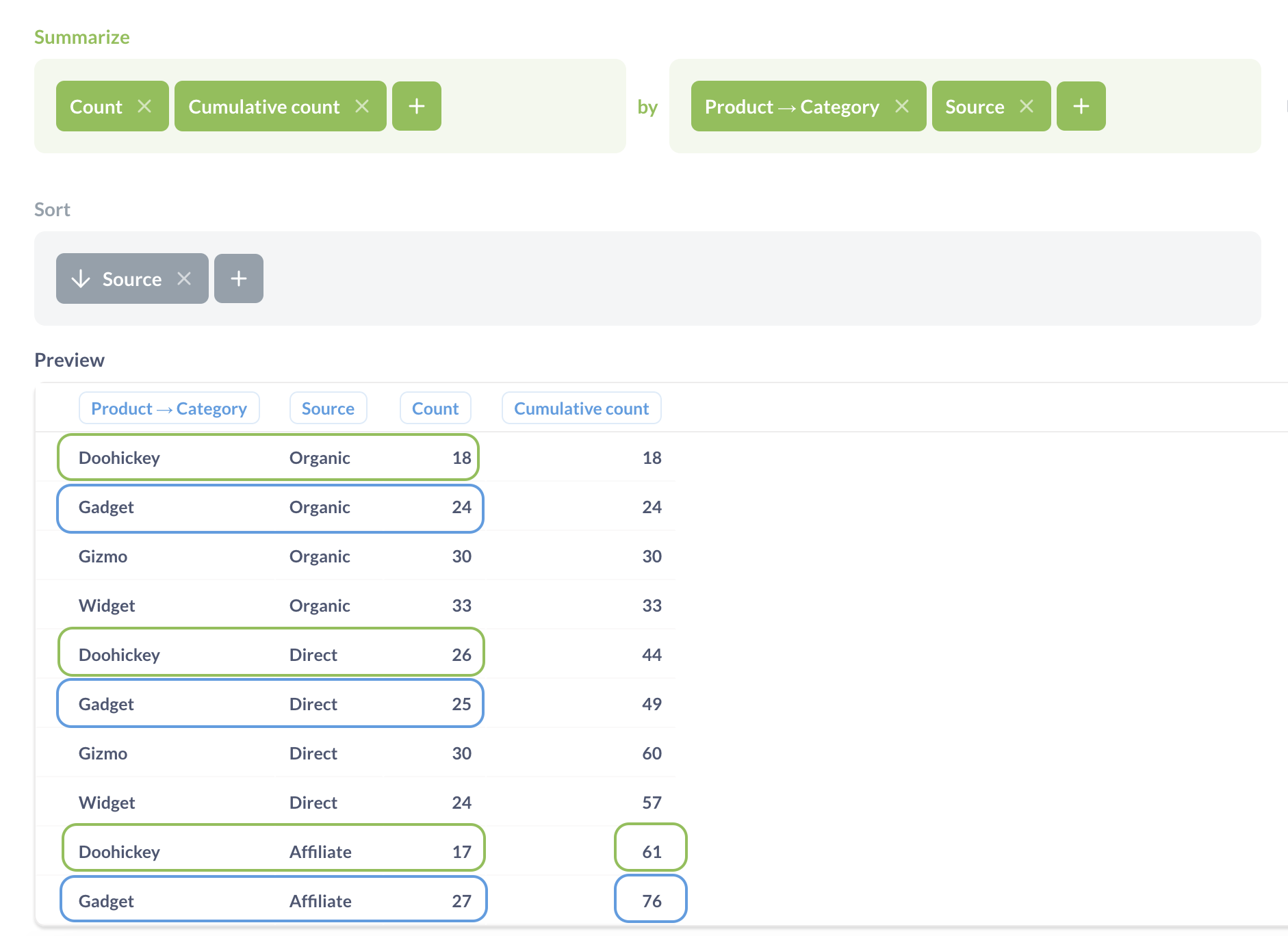Cumulative count and sum
Cumulative count computes the additive total count of rows across a breakout. Cumulative sum computes the rolling sum (also known as running total) of a column across a breakout.
Syntax
You can use the predefined “Cumulative count” and “Cumulative sum” metrics, or a custom expression:
CumulativeCount
CumulativeSum(column)
Cumulative metrics can only be used in the query builder’s Summarize step — you can’t use cumulative metrics to create a custom column or filter.
How cumulative metrics are computed
Under the hood, the cumulative count is computed in three steps:
- Group records using the breakout from the Group by block.
- Count the rows in each group.
- For each group, compute the cumulative total of the counts in all previous groups, including the current group.
Because cumulative metrics use values from previous rows, the sort order in the breakout column matters.
For example, if you have a table with data grouped by month, Metabase will compute the cumulative count like this:
| Month | Count() |
CumulativeCount() |
|---|---|---|
| July | 5 | 5 |
| November | 4 | 5 + 4 = 9 |
| March | 2 | 5 + 4 + 2 = 11 |
If the sort is changed (while values remain the same), then the cumulative count changes as well:
| Month | Count() |
CumulativeCount() |
|---|---|---|
| March | 2 | 2 |
| July | 5 | 2 + 5 = 7 |
| November | 4 | 2 + 5 + 4 = 11 |
When you have only one breakout in the query, Metabase will sort the data by the breakout column in ascending order (using the logic that your database uses for the column’s data type). To change how Metabase accumulates the metric, you can add a Sort block for the breakout column.
Cumulative metrics with multiple breakouts
Because cumulative metrics calculate their summaries based on previous rows, Metabase needs to determine what those previous rows are. Metabase will decide how to compute and display the cumulative metric first based on whether you’re grouping by a datetime column, then by the order of other breakouts:
Queries with a datetime dimension
If you use a datetime dimension in the Group by block, Metabase will accumulate along the datetime dimension, then break out by any other fields in the Group by block (in order):

If there are multiple datetime dimensions (including multiple groupings by the same datetime column), Metabase will accumulate along the more granular dimension, regardless of their order. For example, if you’re grouping by “Created At: Month” and “Viewed At: Week”, Metabase will accumulate along “Viewed At: Week”.

In queries with a datetime dimension, Sort blocks for non-datetime fields won’t affect how Metabase computes the results. Sort blocks will only affect the order of breakouts in the results.
Queries without datetime dimension
If there is no datetime field in the Group by block, Metabase will accumulate along the last dimension specified in the Group By block, and break out by the other fields in their order, from left to right.

By default, Metabase will use ascending sort for the dimension used for accumulation. You can add a Sort block for the accumulation dimension to change the order, which will change both how Metabase computes the cumulative metric and, how it presents the results.

Sorting by any field other than the last (accumulation) field only affects the order of breakouts in the results. It won’t change how Metabase computes the results.
Related functions
Cumulative count in SQL
In SQL, you can use window functions to compute cumulative metrics. For example, to compute cumulative count of orders over months, you can use the following query:
SELECT
created_month,
SUM(count(*)) OVER (
ORDER BY
created_month ASC ROWS UNBOUNDED PRECEDING
) AS "sum"
FROM
(
SELECT
quantity,
DATE_TRUNC ('month', created_at) AS created_month
FROM
orders
)
GROUP BY
created_month
ORDER BY
created_month ASC
Cumulative sums in SQL
For cumulative sums, you can use:
SELECT
created_month,
SUM(SUM(quantity)) OVER (
ORDER BY
created_month ASC ROWS UNBOUNDED PRECEDING
) AS "sum"
FROM
(
SELECT
quantity,
DATE_TRUNC ('month', created_at) AS created_month
FROM
orders
)
GROUP BY
created_month
ORDER BY
created_month ASC
You can view the SQL generated by a query in the query builder by clicking on the View SQL (>_) button in the top right corner.
Read docs for other versions of Metabase.


